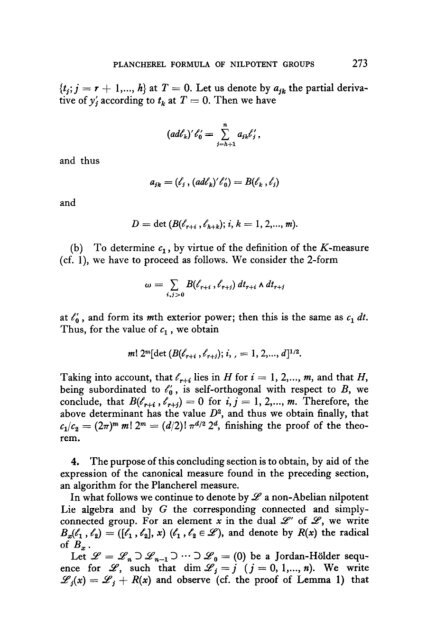On the Characters and the Plancherel Formula of Nilpotent Groups ...
On the Characters and the Plancherel Formula of Nilpotent Groups ...
On the Characters and the Plancherel Formula of Nilpotent Groups ...
You also want an ePaper? Increase the reach of your titles
YUMPU automatically turns print PDFs into web optimized ePapers that Google loves.
PLANCHEREL FORMULA OF NILPOTENT GROUPS 273<br />
(tj;j = r + l,..., h} at T = 0. Let us denote by a*, <strong>the</strong> partial deriva-<br />
tive <strong>of</strong> y; according to tk at T = 0. Then we have<br />
<strong>and</strong> thus<br />
<strong>and</strong><br />
D = det (B(t,.+i , /h+k); i, k = 1,2 ,..., m).<br />
(b) To determine c,, b y virtue <strong>of</strong> <strong>the</strong> definition <strong>of</strong> <strong>the</strong> K-measure<br />
(cf. l), we have to proceed as follows. We consider <strong>the</strong> 2-form<br />
w = C B(lr+d 9 tT+j) dtr+i A &+j<br />
i.j>O<br />
at 8; , <strong>and</strong> form its mth exterior power; <strong>the</strong>n this is <strong>the</strong> same as ci dt.<br />
Thus, for <strong>the</strong> value <strong>of</strong> ci , we obtain<br />
m! 2m[det (B(87+i , /,.+j); i, , = 1, 2 ,..., d]l12.<br />
Taking into account, that c!,.+$ lies in H for i = 1,2,..., m, <strong>and</strong> that H,<br />
being subordinated to 8;) is self-orthogonal with respect to B, we<br />
conclude, that B(c!,+{ , l+.+$) = 0 for i, j = 1, 2 ,..., m. Therefore, <strong>the</strong><br />
above determinant has <strong>the</strong> value D2, <strong>and</strong> thus we obtain finally, that<br />
cl/c2 = (2~)~ m! 2” = (d/2) ! #I2 2d, finishing <strong>the</strong> pro<strong>of</strong> <strong>of</strong> <strong>the</strong> <strong>the</strong>orem.<br />
4, The purpose <strong>of</strong> this concluding section is to obtain, by aid <strong>of</strong> <strong>the</strong><br />
expression <strong>of</strong> <strong>the</strong> canonical measure found in <strong>the</strong> preceding section,<br />
an algorithm for <strong>the</strong> <strong>Plancherel</strong> measure.<br />
In what follows we continue to denote by $4 a non-Abelian nilpotent<br />
Lie algebra <strong>and</strong> by G <strong>the</strong> corresponding connected <strong>and</strong> simplyconnected<br />
group. For an element x in <strong>the</strong> dual 9 <strong>of</strong> 3, we write<br />
B& , /,) = ([/r , &a], x) (8, , l2 E S), <strong>and</strong> denote by R(x) <strong>the</strong> radical<br />
<strong>of</strong> B,.<br />
Let 9 = -E”, 3 Yn-, 3 a** 3 dpO = (0) be a Jordan-Holder sequence<br />
for 9, such that dim ~j = j (j = 0, l,..., n). We write<br />
6pi(x) = ..Yj + R(X) <strong>and</strong> o b serve (cf. <strong>the</strong> pro<strong>of</strong> <strong>of</strong> Lemma 1) that

















